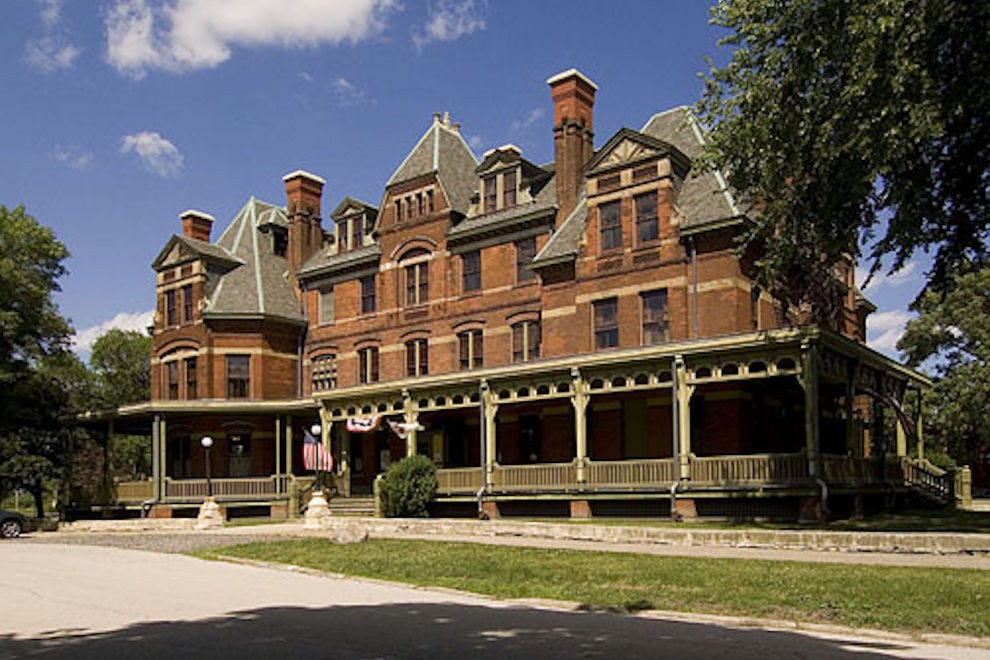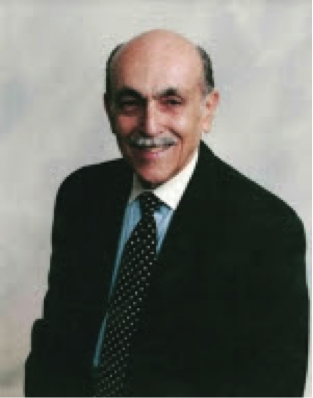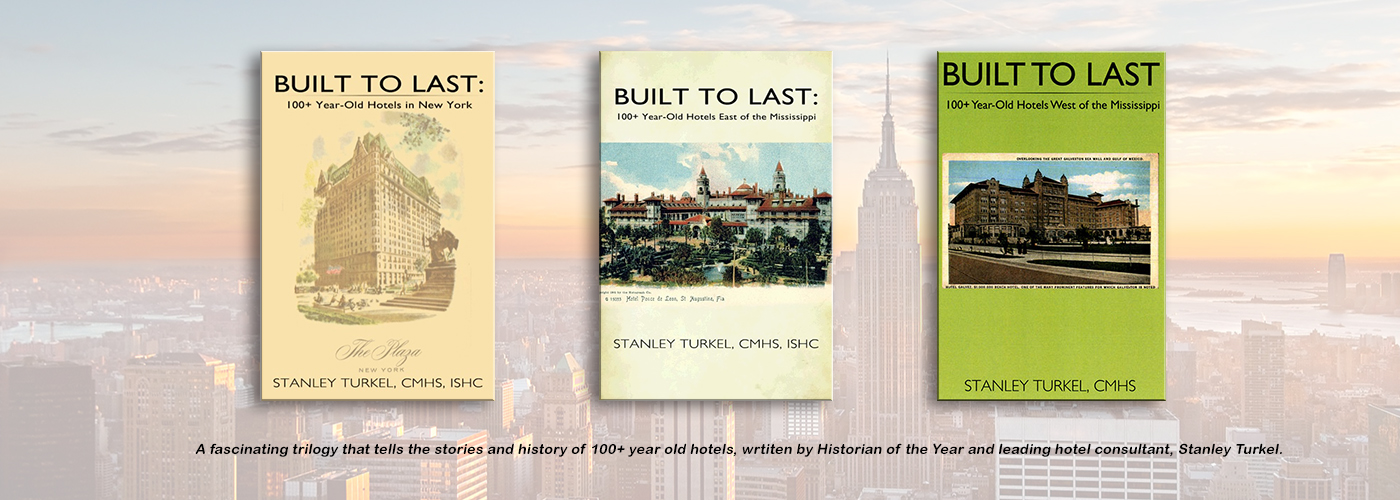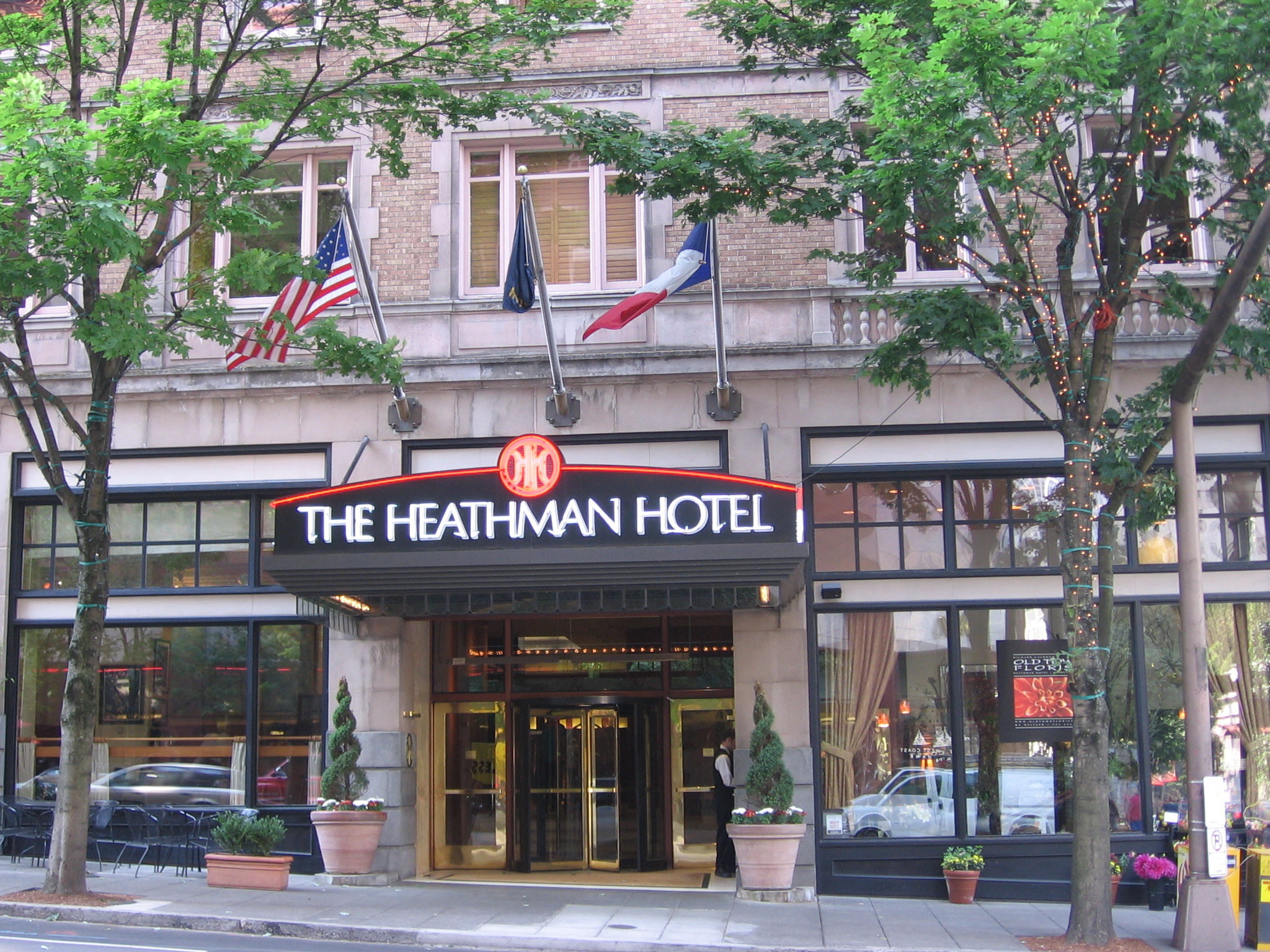Nobody Asked Me, But… No. 221: Hotel History: Hotel Florence
By Stanley Turkel | October 22, 2019

By Stanley Turkel, CMHS
Hotel History: Hotel Florence
The Hotel Florence is a former operating hotel located in the Pullman Historic District on the far south side of Chicago, Illinois. In 1880, the railroad pioneer George Pullman purchased a site of 3,500 acres near Lake Calumet on the Illinois Central Railroad. With demand exploding for his sleeping railroad cars. Pullman decided to build the largest factory to produce them and a company town to house his employees and their families. Pullman believed that if he built a town without saloons and agitators, his workers would be forever loyal to the Pullman creed. Pullman City ultimately grew to 12,000 inhabitants. It had its own shopping center, a savings bank, theater, church, schools and playgrounds. It also had a library of 8,000 books and the luxurious Hotel Florence (named after Pullman’s daughter). Pullman City and the Hotel Florence were designed by architect Solon Spencer Beman (1853-1914). Several of Beman’s largest commissions including the Pullman Office Building, Pabst Building and the Grand Central Station in Chicago have since been demolished. Beman also designed many Christian Science churches. Celebrated at first for good planning Pullman City’s reputation suffered when the Pullman Palace Car Company refused to lower rents after cutting wages, starting the violent national Pullman strike.
The Hotel Florence was chiefly remarkable for the elegance and beauty of design and finish, together with its luxury in furniture, fixtures and appliances, all combined making it equal, save that of size, to the most costly hotels in any of the large cities.
The building rises to a height of four stories above the half basement, the upper lines being broken by a fanciful roof of gables and dormer windows, which makes the building resemble a fine large mansion more than it does a hotel. A veranda 16 feet wide and 268 feet long extends along the front and sides of the building which is treated in East Lake and Queen Anne designs, the ceiling being painted a light sky blue, which harmonizes perfectly with the deep red of the brick of which the walls are constructed. A short flight of steps give approach to the central portion of the veranda in front, upon which the office and rotunda opens through wide doors of polished cherry. When entering the lobby, the Tennessee marble counter surmounted at one end by a handsome cherry desk, is in full view of the entrance to the parlor and the gentlemen’s reading room. Immediately beyond the latter is the billiard room across the hall from the lunch room and saloon designed for guests of the hotel. Large open fire places welcome you upon entering the lobby, parlors and dining room.
The furniture of the parlor is made of solid mahogany and upholstered with heavy Maroon velvet plush. The dining room is immediately across the hall from the parlor and is L shaped. The original portion of the hotel had 50 sleeping rooms, a dining room, a billiard room barber shop, separate men’s and women’s parlors and the only bar in Pullman City. The building was originally lighted with gas lights and heated with steam radiators, the steam generated by the Corliss Engine located across the street in the factory buildings.
The first floor and the Pullman Suite were trimmed with cherry woodwork and accented by multicolored stained glass windows. On the second floor, the Pullman Suite was kept for George Pullman when he visited the factory and town as the Pullman family lived in the fashionable Prairie Avenue District, just south of downtown.
The second through the fourth floors housed the hotel rooms and suites. Each floor, similar to train cars, provided a different “class” of service. The more elegant and expensive rooms were located on the second floor, where they were closer to the lobby. These rooms were outfitted with Eastlake furniture and included larger suite layouts. The rooms on the third and fourth floors were smaller and furnished in different styles on each floor.
The hotel was off limits to Pullman workers. George Pullman did not want his laborers to drink and banned the sale of alcohol within town limits. An exception was made for guests of the Hotel Florence, however. A bar served whiskey and other beverages inside the hotel. The hotel restaurant specialized in pork chops which were featured on the hotel menu in 1902.
The Historic Pullman Foundation bought the Hotel Florence in 1975 to save the aging building from demolition and to renovate it. In 1991, it was sold to the Illinois Historic Preservation Agency as an integral part of the Pullman State Historic Site. The Hotel is open for tours and special events.
My New Book, “Great American Hotel Architects” is Available
My eighth hotel history book features twelve architects who designed 94 hotels from 1878 to 1948: Warren & Wetmore, Henry J. Hardenbergh, Schultze & Weaver, Mary Elizabeth Jane Colter, Bruce Price, Mulliken & Moeller, McKim, Mead & White, Carrere & Hastings, Julia Morgan, Emery Roth, Trowbridge & Livingston, George B. Post and Sons.
You can order copies from the publisher AuthorHouse by posting “Great American Hotel Architects” by Stanley Turkel.
My Other Published Hotel Books
- Great American Hoteliers: Pioneers of the Hotel Industry (2009)
- Built To Last: 100+ Year-Old Hotels in New York (2011)
- Built To Last: 100+ Year-Old Hotels East of the Mississippi (2013)
- Hotel Mavens: Lucius M. Boomer, George C. Boldt, Oscar of the Waldorf (2014)
- Great American Hoteliers Volume 2: Pioneers of the Hotel Industry (2016)
- Built To Last: 100+ Year-Old Hotels West of the Mississippi (2017)
- Hotel Mavens Volume 2: Henry Morrison Flagler, Henry Bradley Plant, Carl
Graham Fisher (2018)
All of these books can be ordered from AuthorHouse by visiting www.stanleyturkel.com and clicking on the book’s title.
If You Need an Expert Witness:
For the past twenty-seven years, I have served as an expert witness in more than 42 hotel-related cases. My extensive hotel operating experience is beneficial in cases involving:
- slip and fall accidents
- wrongful deaths
- fire and carbon monoxide injuries
- hotel security issues
- dram shop requirements
- hurricane damage and/or business interruption cases
Feel free to call me at no charge on 917-628-8549 to discuss any hotel-related expert witness assignment.237
ABOUT STANLEY TURKEL

Stanley Turkel was designated as the 2014 and the 2015 Historian of the Year by Historic Hotels of America, the official program of the National Trust for Historic Preservation. This award is presented to an individual for making a unique contribution in the research and presentation of hotel history and whose work has encouraged a wide discussion and a greater understanding and enthusiasm for American History.
Turkel is the most widely-published hotel consultant in the United States. He operates his hotel consulting practice serving as an expert witness in hotel-related cases, provides asset management and hotel franchising consultation. He is certified as a Master Hotel Supplier Emeritus by the Educational Institute of the American Hotel and Lodging Association.
Contact: Stanley Turkel
stanturkel@aol.com/917-628-8549
Categories
- Industry Happenings (25,405)
- Technology (4,699)
- All Things Independent (3,705)
- Operations (3,638)
- Latest news (1,769)
- Market Reports (1,466)
- Development (1,239)
- Finance (1,147)
- Real Estate (966)
- Smart Strategies (942)
hotelonlinenewsFollow on Instagram
Tags
hotel florencehotel historynobody asked mepullman historic districtstan turkelstanley turkel
RELATED NEWS:
Nobody Asked Me, But… No. 220: Hotel History: The Heathman HotelNobody Asked Me, But… No. 219: Hotel History: Josh Billings on Hotels One Hundred and Forty-Eight Years AgoStolen Coffee Pot Wins New Orleans Local $15,000 Roosevelt Hotel StayNobody Asked Me, But… No. 218; Hotel History: Raymond Orteig and Charles LindberghNobody Asked Me, But… No. 217, Hotel History: Catskill Mountain Resort HotelsNobody Asked Me, But… No. 216: Hotel History: Ellsworth M. StatlerNobody Asked Me, But… No. 215: Hotel History: The TWA HotelNobody Asked Me, But… No. 214: Hotel History: Shepheard’s Hotel, Cairo, EgyptNobody Asked Me, But… No. 213: Hotel History: Sheraton’s Classic Advertising CampaignsNobody Asked Me, But… No. 212: Hotel History: Hotel del Coronado, Coronado, California (1888)Nobody Asked Me, But… No. 211: Hotel History: Asian American Hotel Owners Association*Nobody Asked Me, But… No. 210: Hotel History: John Q. Hammons (1919-2013)Nobody Asked Me, But… No. 209: Hotel History: The Americana of New York (1962)Nobody Asked Me, But… No. 208: Hotel History: Grand Hotel (1887) Mackinac Island, MichiganNobody Asked Me, But… No. 207: Hotel History in Brooklyn, N.Y.: Hotel Bossert (1909) and St. George Hotel (1885)Nobody Asked Me, But… No. 203: Hotel History: The Skirvin Hotel, Oklahoma City, Oklahoma (225 Rooms)Hilton Singapore Welcomes New Executive Chef Kazi HassanNobody Asked Me, But… No. 202: Hotel History: Mayflower Hotel, Washington, D.C.Nobody Asked Me, But… No. 201: Hotel History: Architect Morris LapidusNobody Asked Me, But… No. 200: Hotel History: Cesar Ritz and Auguste Escoffier

